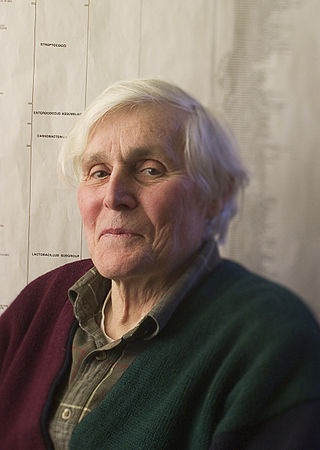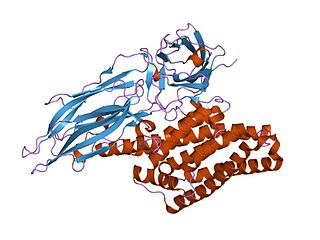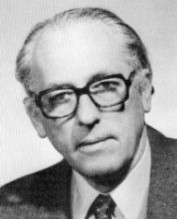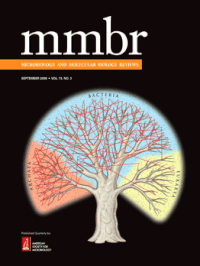
Carl Richard Woese was an American microbiologist and biophysicist. Woese is famous for defining the Archaea in 1977 through a pioneering phylogenetic taxonomy of 16S ribosomal RNA, a technique that has revolutionized microbiology. He also originated the RNA world hypothesis in 1967, although not by that name. Woese held the Stanley O. Ikenberry Chair and was professor of microbiology at the University of Illinois at Urbana-Champaign.

A prophage is a bacteriophage genome that is integrated into the circular bacterial chromosome or exists as an extrachromosomal plasmid within the bacterial cell. Integration of prophages into the bacterial host is the characteristic step of the lysogenic cycle of temperate phages. Prophages remain latent in the genome through multiple cell divisions until activation by an external factor, such as UV light, leading to production of new phage particles that will lyse the cell and spread. As ubiquitous mobile genetic elements, prophages play important roles in bacterial genetics and evolution, such as in the acquisition of virulence factors.

The American Society for Microbiology (ASM), originally the Society of American Bacteriologists, is a professional organization for scientists who study viruses, bacteria, fungi, algae, and protozoa as well as other aspects of microbiology. It was founded in 1899. The Society publishes a variety of scientific journals, textbooks, and other educational materials related to microbiology and infectious diseases. ASM organizes annual meetings, as well as workshops and professional development opportunities for its members.

Coenzyme M is a coenzyme required for methyl-transfer reactions in the metabolism of archaeal methanogens, and in the metabolism of other substrates in bacteria. It is also a necessary cofactor in the metabolic pathway of alkene-oxidizing bacteria. CoM helps eliminate the toxic epoxides formed from the oxidation of alkenes such as propylene. The structure of this coenzyme was discovered by CD Taylor and RS Wolfe in 1974 while they were studying methanogenesis, the process by which carbon dioxide is transformed into methane in some anaerobic bacteria. The coenzyme is an anion with the formula HSCH
2CH
2SO−
3. It is named 2-mercaptoethanesulfonate and abbreviated HS–CoM. The cation is unimportant, but the sodium salt is most available. Mercaptoethanesulfonate contains both a thiol, which is the main site of reactivity, and a sulfonate group, which confers solubility in aqueous media.

Lorna Ann Casselton, was a British academic and biologist. She was Professor Emeritus of Fungal Genetics in the Department of Plant Science at the University of Oxford, and was known for her genetic and molecular analysis of the mushroom Coprinus cinereus and Coprinus lagopus.

Bacteria are ubiquitous, mostly free-living organisms often consisting of one biological cell. They constitute a large domain of prokaryotic microorganisms. Typically a few micrometres in length, bacteria were among the first life forms to appear on Earth, and are present in most of its habitats. Bacteria inhabit soil, water, acidic hot springs, radioactive waste, and the deep biosphere of Earth's crust. Bacteria play a vital role in many stages of the nutrient cycle by recycling nutrients and the fixation of nitrogen from the atmosphere. The nutrient cycle includes the decomposition of dead bodies; bacteria are responsible for the putrefaction stage in this process. In the biological communities surrounding hydrothermal vents and cold seeps, extremophile bacteria provide the nutrients needed to sustain life by converting dissolved compounds, such as hydrogen sulphide and methane, to energy. Bacteria also live in symbiotic and parasitic relationships with plants and animals. Most bacteria have not been characterised and there are many species that cannot be grown in the laboratory. The study of bacteria is known as bacteriology, a branch of microbiology.
Biosurfactant usually refers to surfactants of microbial origin. Most of the biosurfactants produced by microbes are synthesized extracellularly and many microbes are known to produce biosurfactants in large relative quantities. Some are of commercial interest. As a secondary metabolite of microorganisms, biosurfactants can be processed by the cultivation of biosurfactant producing microorganisms in the stationary phase on many sorts of low-priced substrates like biochar, plant oils, carbohydrates, wastes, etc. High-level production of biosurfactants can be controlled by regulation of environmental factors and growth circumstances.

Delta endotoxins (δ-endotoxins) are pore-forming toxins produced by Bacillus thuringiensis species of bacteria. They are useful for their insecticidal action and are the primary toxin produced by Bt maize/corn. During spore formation the bacteria produce crystals of such proteins that are also known as parasporal bodies, next to the endospores; as a result some members are known as a parasporin. The Cyt (cytolytic) toxin group is a group of delta-endotoxins different from the Cry group.

A prokaryote is a single-celled organism that lacks a nucleus and other membrane-bound organelles. The word prokaryote comes from the Greek πρό and κάρυον. In the two-empire system arising from the work of Édouard Chatton, prokaryotes were classified within the empire Prokaryota. But in the three-domain system, based upon molecular analysis, prokaryotes are divided into two domains: Bacteria and Archaea. Organisms with nuclei are placed in a third domain, Eukaryota. In biological evolution, prokaryotes are deemed to have arisen before eukaryotes.

Gliding motility is a type of translocation used by microorganisms that is independent of propulsive structures such as flagella, pili, and fimbriae. Gliding allows microorganisms to travel along the surface of low aqueous films. The mechanisms of this motility are only partially known.

Roger Yate Stanier was a Canadian microbiologist who was influential in the development of modern microbiology. As a member of the Delft School and former student of C. B. van Niel, he made important contributions to the taxonomy of bacteria, including the classification of blue-green algae as cyanobacteria. In 1957, he and co-authors wrote The Microbial World, an influential microbiology textbook which was published in five editions over three decades. In the course of 24 years at the University of California, Berkeley he reached the rank of professor and served as chair of the Department of Bacteriology before leaving for the Pasteur Institute in 1971. He received several awards over the course of his career, including the Leeuwenhoek Medal. He was a Fellow of the Royal Society and a Foreign Associate of the National Academy of Sciences and the Légion d’Honneur.
Thermococcus alcaliphilus is a hyperthermophilic archaeon. It is coccoid-shaped and heterotrophic, first isolated from a shallow marine hydrothermal system at Vulcano Island, Italy. Its type strain is AEDII12.
Bacillus aerius is a species of bacteria first isolated from cryogenic tubes used for collecting air samples from high altitudes, hence its name. Its type strain is 24KT.

A septum in cell biology is the new cell wall that forms between two daughter cells as a result of cell division.

Dr. Paul B. Rothman is the Frances Watt Baker, M.D., and Lenox D. Baker Jr., M.D., Dean of the Medical Faculty, vice president for medicine at Johns Hopkins University, and CEO of Johns Hopkins Medicine. As dean and CEO, Dr. Rothman oversees both the School of Medicine and the Johns Hopkins Health System, which together encompass six hospitals, hundreds of faculty and community physicians and a self-funded health plan.
Marilyn S. Kozak is an American professor of biochemistry at the Robert Wood Johnson Medical School. She was previously at the University of Medicine and Dentistry of New Jersey before the school was merged. She was awarded a PhD in microbiology by Johns Hopkins University studying the synthesis of the Bacteriophage MS2, advised by Daniel Nathans. In her original faculty job proposal, she sought to study the mechanism of eukaryotic translation initiation, a problem long thought to have already been solved by Joan Steitz. While in the Department of Biological Sciences at University of Pittsburgh, she published a series of studies that established the scanning model of translation initiation and the Kozak consensus sequence. Her current research interests are unknown as her last publication was in 2008.
The T4 Holin Family is a group of putative pore-forming proteins that does not belong to one of the seven holin superfamilies. T-even phage such as T4 use a holin-endolysin system for host cell lysis. Although the endolysin of phage T4 encoded by the e gene was identified in 1961, the holin was not characterized until 2001. A representative list of proteins belonging to the T4 holin family can be found in the Transporter Classification Database.
Hamster polyomavirus is an unenveloped double-stranded DNA virus of the polyomavirus family whose natural host is the hamster. It was originally described in 1967 by Arnold Graffi as a cause of epithelioma in Syrian hamsters.
The middle tumor antigen is a protein encoded in the genomes of some polyomaviruses, which are small double-stranded DNA viruses. MTag is expressed early in the infectious cycle along with two other related proteins, the small tumor antigen and large tumor antigen. MTag occurs only in a few known polyomaviruses, while STag and LTag are universal - it was first identified in mouse polyomavirus (MPyV), the first polyomavirus discovered, and also occurs in hamster polyomavirus. In MPyV, MTag is an efficient oncoprotein that can be sufficient to induce neoplastic transformation in some cells.
Perry William Wilson was an American microbiologist and biochemist. He gained a scientific reputation as an outstanding pioneer in transforming the science of biological nitrogen fixation. His research helped to transform a mainly descriptive science into a more quantitative and analytic science based on biochemistry and statistical methods and control in bacteriology. He was called the "dean of biological nitrogen fixation".













